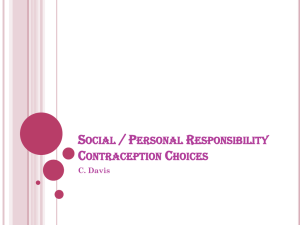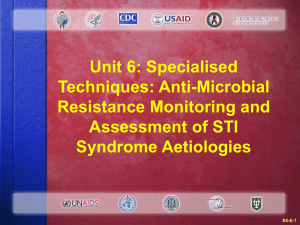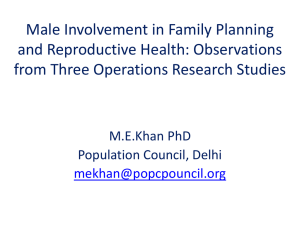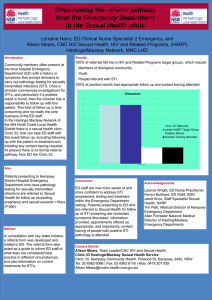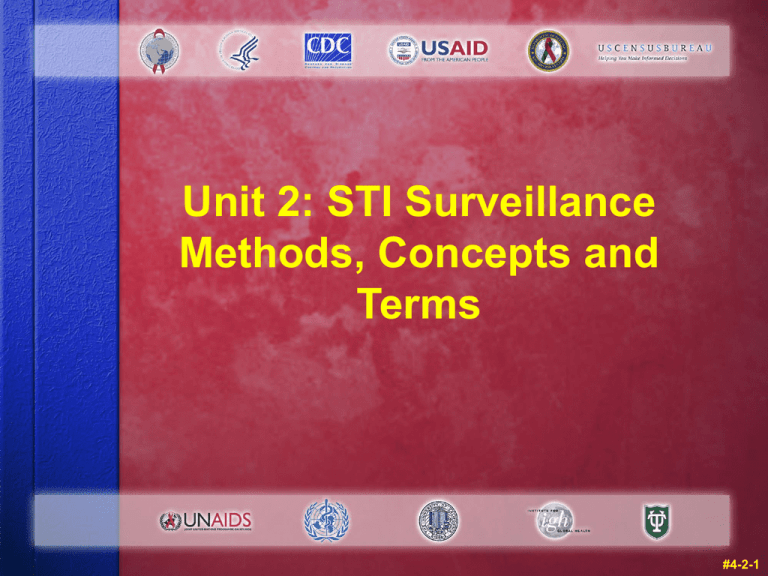
Unit 2: STI Surveillance
Methods, Concepts and
Terms
#4-2-1
Warm Up Questions: Instructions
Take five minutes now to try the Unit 2 warm
up questions in your manual.
Please do not compare answers with other
participants.
Your answers will not be collected or graded.
We will review your answers at the end of the
unit.
#4-2-2
What You Will Learn
By the end of this unit you should be able to:
discuss the components of an STI surveillance system
discuss the uses of STI surveillance data
describe the difference between aetiologic and
syndromic STI diagnosis and surveillance
determine the difference between basic and advanced
STI surveillance activities and how these activities
should be used, depending on the type of HIV epidemic
describe IDS case reporting
#4-2-3
Figure 2.1. Components of an STI
Surveillance System
#4-2-4
Which Components Should Be
Used?
Some components are more important for secondgeneration HIV surveillance activities, such as:
combined STI/HIV behavioural surveillance surveys
Others are important to STI control programme activities:
assessing syndrome aetiologies
anti-microbial resistance monitoring
Some are important for both:
STI case reporting
STI prevalence assessment and monitoring
#4-2-5
Which Components Should Be
Used, Cont.
Consider existing programmes in your country,
especially the following issues:
the needs of STI control programmes
established by your Ministry of Health
existing surveillance systems for other
communicable diseases
the health management information used
existing health services infrastructure
the state of the HIV epidemic in your country
#4-2-6
Symptomatic and Asymptomatic
STIs
To accurately calculate incidence and prevalence,
the STI surveillance system needs to identify:
which STIs are newly acquired
which have been present for a long time
To identify these conditions, it is important to
understand the role of symptomatic and
asymptomatic STIs.
#4-2-7
Symptomatic STIs
Symptomatic infections are recently acquired and
represent true incidence.
Herpes simplex virus is an exception since
symptoms can recur without new infection, making
it impossible to determine the duration of infection.
Examples include:
chancroid
gonorrhea
early syphilis
chlamydia
#4-2-8
Asymptomatic STIs
Asymptomatic infections do not produce symptoms.
They can be present for a long time without
patients knowing they are infected.
They are more useful for calculating prevalence
than incidence.
Examples include (but are not limited to):
latent syphilis
chronic Herpes simplex virus type 2
chlamydia
gonorrhoea
#4-2-9
How STI Surveillance Data Are
Used
Assess overall burden of STIs
Monitor trends in recently acquired STIs
Provide information for physicians to treat STI patients
and their sex partners
Provide information to assist in planning and managing
STI and HIV prevention and control programme efforts
Provide data for advocacy, resource mobilisation,
programme planning, targeting, monitoring & evaluation
Serve as a marker of HIV risk behaviours
Monitor the number of people infected with HIV who
develop an STI
#4-2-10
Aetiologic and Syndromic
Case Reporting
STI cases can be reported by one of the
following strategies:
In aetiologic case reporting, the specific STI
pathogen is identified by laboratory methods to
make a diagnosis.
In syndromic case reporting, the symptom
complex is used for diagnosis in the absence of
laboratory confirmation of the STI pathogen.
#4-2-11
Aetiologic Case Reporting
Aetiologic case reporting requires laboratory
confirmation of diagnoses.
Aetiological case reporting is only possible where
well-developed systems of laboratory diagnosis
are incorporated into routine STI clinical case
management.
In Africa, the use of laboratory services for
diagnosis is often not available for routine care,
so the syndromic approach is recommended.
#4-2-12
Syndromic Case Reporting
Only urethral discharge in men and genital
ulcers in men and women reflect recent
infection. Therefore, they are important for
detecting trends in STI incidence.
Syndromic case reports are a poor tool for
assessing disease burden among women, since
women’s infections are often asymptomatic.
#4-2-13
Syndromic Case Reporting, Cont.
Gonorrhoea and chlamydia infections in women
may be symptomatic, but the symptoms are
difficult to distinguish from other conditions.
When possible, STI prevalence assessment and
monitoring for women should be undertaken as
a supplement to case reporting.
#4-2-14
Case Definitions
When syndromic case reporting is used,
healthcare workers should make diagnoses
based on a standard case definition.
Uniform case definitions should be used
throughout the country.
Cases should only be recorded if they meet the
standard case definition, not simply based on
the assigned diagnosis.
#4-2-15
Table 2.1. Recommended Case
Definitions for Select STI Syndromes
STI
syndrome
Case definition
urethral
discharge in
men with or
without dysuria
ulcers on the
penis, scrotum
or rectum in men
ulcers on the
labia, vagina or
rectum in
women
Urethral
discharge
Genital ulcer
(nonvesicular)
Source: UNAIDS/WHO, 1999.
Additional information
caused by N. gonorrhoeae
and C. trachomatis
other possible infectious
agents include T. vaginalis, U.
urealyticum and Mycoplasma
spp.
caused by syphilis, chancroid,
lymphogranuloma venereum,
granuloma inguinale or
atypical types of genital
herpes
reporting only non-vesicular
genital ulcers excludes most
herpes infections
#4-2-16
Using the IDS Strategy to Report
Under IDS, STI cases are reported from the
district using forms similar to those used for
other priority communicable diseases.
Data are collected, analysed and disseminated
in an integrated way.
The STI portion of IDS includes reports for:
cases of urethral discharge in men
cases of non-vesicular genital ulcers in men and
women
#4-2-17
Table 2.2. Recommended
Aetiological Case Definitions for
Selected STI Syndromes
Chlamydia, Confirmed
Case definition:
positive culture
direct fluorescent antibody test
antigen detection or nucleic acid-based test for C. trachomatis taken from
a genital site (some nucleic acid-based tests can be done on urine)
Syphilis (latent), Probable
Case definition:
no clinical signs or symptoms of syphilis
either a reactive non-treponemal or treponemal test in a patient with no
prior syphilis diagnosis or
non-treponemal test titre demonstrating at least a four-fold increase from
the last treponemal test titre in a patient with a prior diagnosis
#4-2-18
Basic and Advanced STI
Surveillance
Two levels of STI surveillance activities can be
planned:
Basic STI surveillance activities should be
undertaken in areas with limited resources.
Advanced STI surveillance activities can be
conducted in countries with more extensive
resources and well-developed laboratories.
#4-2-19
Table 2.3. Comparing the
Approach for Basic and Advanced
STI Surveillance
Basic Surveillance
Advanced Surveillance
Sentinel
Aetiologic
or universal
syndromic reporting (with
minimal data elements
collected) of:
male
urethral
discharge
reporting of:
syphilis
(by stage)
gonorrhoea
chlamydia
non-vesicular
genital
ulcer disease in men
and women
#4-2-20
Table 2.3. Comparing Prevalence
Assessment and Monitoring for
Basic and Advanced Surveillance
Basic Surveillance
Advanced Surveillance
Conduct
Conduct
periodically
in high-risk
populations
periodically in general
and high-risk populations:
Test
all pregnant
women for syphilis
Focus
only on
serologic testing for
syphilis
women at family planning clinics
military recruits
sex workers, STI patients
Include urine testing for
gonorrhoea and chlamydia and
serologic testing for syphilis
Can be combined with
behavioural surveys
#4-2-21
Table 2.3. Comparing Assessment
of Syndrome Aetiologies for Basic
and Advanced Surveillance
Basic Surveillance
Advanced Surveillance
Assess
Assess
genital ulcer
disease and urethral and
vaginal discharge every
three years
causes of genital
ulcer disease at least
every three years
Assessment
of genital
discharge is not needed
because aetiologic case
reporting is used
#4-2-22
Table 2.3. Comparing Special
Studies for Basic and Advanced
STI Surveillance
Basic Surveillance
Investigate:
anti-microbial
resistance
monitoring for N.
gonorrhoeae
annually
conduct evaluation
of STI treatment
guidelines every
three years
Advanced Surveillance
Investigate outbreaks of diseases
with low incidence
Conduct special studies of:
anti-microbial resistance
monitoring for N. gonorrhoeae
annually
serologic surveys of HSV-2
especially in adolescents and
young adults
human papilloma virus infections
prevalence studies of bacterial
vaginosis
#4-2-23
Table 2.4. Planning for Advanced
STI Surveillance
Epidemic state
Low-level
Concentrated
Generalised
Your STI surveillance plan
Conduct prevalence assessments in
urban areas (where the risk is initially
greatest)
Conduct prevalence assessments in
both rural and urban areas to monitor
spread from urban to rural areas
Conduct prevalence assessments in
both rural and urban areas to monitor
the spread from urban to rural areas.
Include monitoring gonorrhoea and
chlamydia.
#4-2-24
In Summary
STI surveillance includes routine data collection
and special studies.
It relies on aetiologic or syndromic case
reporting, but syndromic case reporting is
recommended for sub-Saharan Africa.
Basic STI surveillance activities should be
undertaken in areas with limited resources.
Advanced activities are conducted where there
are more resources and better laboratories.
#4-1-25
Warm Up Review
Take a few minutes now to look back at your
answers to the warm up questions at the
beginning of the unit.
Make any changes you want to.
We will discuss the questions and answers in
a few minutes.
#4-2-26
Answers to Warm Up Questions
1. True or false? Some elements of an STI
surveillance system are more important for
HIV surveillance activities. Others are more
important for STI control programme activities.
#4-2-27
Answers to Warm Up Questions
1. True or false? Some elements of an STI
surveillance system are more important for
HIV surveillance activities. Others are more
important for STI control programme activities.
True
#4-2-28
Answers to Warm Up Questions,
Cont.
2. True or false? STI surveillance data can
serve as an indicator of trends in HIV risk
behaviours.
#4-2-29
Answers to Warm Up Questions,
Cont.
2. True or false? STI surveillance data can
serve as an indicator of trends in HIV risk
behaviours. True
#4-2-30
Answers to Warm Up Questions,
Cont.
3. True or false? Aetiologic reporting of syphilis
(by stage), gonorrhoea, chlamydia, and
congenital syphilis is considered a basic
surveillance activity in the African region.
#4-2-31
Answers to Warm Up Questions,
Cont.
3. True or false? Aetiologic reporting of syphilis
(by stage), gonorrhoea, chlamydia, and
congenital syphilis is considered a basic
surveillance activity in the African region.
False
#4-2-32
Answers to Warm Up Questions,
Cont.
4. Which of the following is not a component of
an STI surveillance system?
a.
b.
c.
d.
STI universal case reporting
STI sentinel surveillance systems
STI testing and treatment
STI prevalence assessment and
monitoring
#4-2-33
Answers to Warm Up Questions,
Cont.
4. Which of the following is not a component of
an STI surveillance system?
a.
b.
c.
d.
STI universal case reporting
STI sentinel surveillance systems
STI testing and treatment
STI prevalence assessment and
monitoring
#4-2-34
Answers to Warm Up Questions,
Cont.
5. True or false? In generalised HIV epidemics,
prevalence assessments should include
monitoring gonorrhoea and chlamydia.
#4-2-35
Answers to Warm Up Questions,
Cont.
5. True or false? In generalised HIV epidemics,
prevalence assessments should include
monitoring gonorrhoea and chlamydia. True
#4-2-36
Answers to Warm Up Questions,
Cont.
6. True or false? An STI surveillance system
includes conditions that are newly acquired,
as well as those that represent past
infections.
#4-2-37
Answers to Warm Up Questions,
Cont.
6. True or false? An STI surveillance system
includes conditions that are newly acquired,
as well as those that represent past
infections. True
#4-2-38
Answers to Warm Up Questions,
Cont.
7. In __________ case reporting, STI cases are
reported by the specific microbial organism
that caused the STI, while in syndromic case
reporting, STI cases are reported by the
clinical syndrome with which the patient
presents.
#4-2-39
Answers to Warm Up Questions,
Cont.
7. In aetiologic case reporting, STI cases are
reported by the specific microbial organism
that caused the STI, while in syndromic case
reporting, STI cases are reported by the
clinical syndrome with which the patient
presents.
#4-2-40
Small Group Discussion:
Instructions
Get into small groups to discuss these
questions.
Choose a speaker for your group who will
report back to the class.
#4-2-41
Small Group Reports
Select one member from your group to
present your answers.
Discuss with the rest of the class.
#4-2-42
Case Study: Instructions
Try this case study individually.
We’ll discuss the answers in class.
#4-2-43
Case Study Review
Follow along as we go over the case study in
class.
Discuss your answers with the rest of the
class.
#4-2-44
Questions, Process Check
Do you have any questions on the information
we just covered?
Are you happy with how we worked on Unit 2?
Do you want to try something different that will
help the group?
#4-2-45


